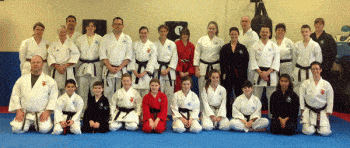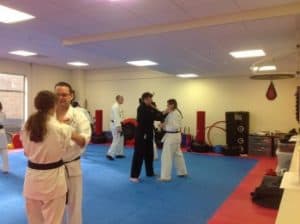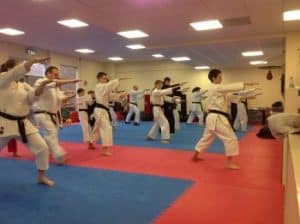
Lindsey began with a brief history of Nipaipo and throughout the Masterclass gave technical tips on how to perform the Kata.
- There is some disagreement of the Meaning of it’s name with some people saying 28 steps and others saying two eight steps. The original meaning has been lost
- It’s also known as Nepai in some styles of Karate.
- Taken originally by Kenwa Mabuni from White Crane style Kung Fu (one of the names it was known as was Er Shi Ba) and adapted to Shito Ryu style of karate. Further adaptations were made by Teruo Hayashi, another exponent of Shito Ryu in the 1980’s.
- It can also be seen in some Kung Fu styles as Quick Fist form (Sangfeng Quaichuan). The Kung Fu version is much softer and more flowing but similarities are still apparent.
- Typically considered as 2nd dan and above level kata, in some groups it’s a 6th Dan level Karate kata.
- Has been taken from Shito Ryu and adapted to suit other styles of karate (e.g. Shorin Ryu).
- Approx 47 moves incorporating punches, kicks, blocks, locks and throws.
Learning and studying Kata is an important part of karate training. As a form of training it teaches us co-ordination, concentration, develops physical strength, speed, focus, power, breath control and martial skill.
The process of learning kata involves many layers of development. Typically we start by looking at the moves and their basic elements such as the placement of the feet and hands and slowly piece together the sequence until we have learnt the whole kata.
We also look at the bunkai or meaning and application of the moves, it’s important to understand the applications which you are practising – if not, then ultimately you are merely performing movements with your hands and feet, like a dance, but you have lost the essence of the martial art which you are trying to learn.
As we become more confident in the sequence we can start to layer in the correct speed, timing, focus and breathing. It is an ongoing learning process and no matter how long you’ve been studying there are always things which can be improved and new and varied applications to be uncovered.
Performing kata in competition adds a new dimension to the challenge. It takes confidence and self-control to perform before judges, spectators and against the abilities of others. It’s amazing how a kata can be performed 100 times in the dojo correctly but when the additional stresses of competition are added the mind goes blank and competitors forget moves or let the nerves take over and lose their strength and spirit. There are some stringent rules applied to competitors which are used to judge a winning performance. There are typically 3 – 5 judges who observe the competitor from different angles and award points based on the following;
In a Kata Match, each performance will not be deemed simply good or bad, but will be judged according to the essential elements in two different criteria:
BASIC PERFORMANCE
The following basic points must appear in each performance of a Kata:
- Kata sequence.
- Control of power.
- Control of tension and contraction.
- Control of speed and rhythm.
- Direction of movements.
- Understanding Kata technique.
- Show proper understanding of the Kata Bunkai.
- Coordination.
- Stability and balance.
- Pauses.
- Kiai.
- Breathing.
- Concentration.
- Spirit.
Judges will note the specific important points and the degree of difficulty of the performed Kata. Judgment will be based on:7
a) The mastery of techniques by the contestant.
b) The degree of difficulty and risk in the performance of the Kata.
c) The Budo attitude of the contestant.
The following youtube clips worth having a look at if you wish to look further into this kata:
http://youtu.be/Bt-jtJOqthw Quickfist form
http://youtu.be/FXzmbgMs-08 Nepai kata
http://youtu.be/5lsb-Rn2pCM Nipaipo kata


